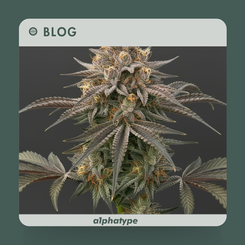Blog: Inbreds or Hybrids: Which Path Leads to the Best Strains?
- Manuel Basegla
- Feb 9, 2024
- 3 min read
Updated: Feb 20
Published 8:00 AM EST, Fri February 09, 2024
Inbreds consolidate stable genetic characteristics transmitted through generations, while hybrids fuse the best of both genetic individuals.
Alphatype utilizes hybrid vigor to create superior cannabis seed varieties, aiming for genetic improvement and preservation.
Heterosis, a result of crossing different genetic profiles, boosts the likelihood of obtaining superior traits in cannabis.
Allogamous physiology and enhancement through heterosis
Inbreds and hybrids represent two genetic approaches that define the morphological and biochemical variability of the cannabis plant. Inbreds, the result of reproductive self-sufficiency, confer stable genetic characteristics transmitted through generations. In contrast, hybrids, the product of the controlled combination of divergent genotypes, merge the best of both genetic individuals.

Before debating what path choose to obtain the cultivars with the best characteristics, it is important to understand the type of physiology that the species have, in the case of plants with high concentrations of cannabinoids, they are mostly of the allogamous type, which means that their fertilization process is based on the separation of sexes between individuals (males and females).
Due to their allogamous nature, batches of cannabis plants selected for specific characteristics rely on the combination of DNA from both parents for reproduction. This leads to a phenomenon called heterosis, which enhances the likelihood of obtaining individuals with superior traits by crossing two inbreds with distinct genetic profiles.
Selection process using recurrent selection techniques
When aiming to conduct a selection process among a plant cultivation to isolate specific traits (e.g., high cannabinoid content, unique coloration, high yield, or organoleptic characteristics) as part of the effort to achieve precise and desired traits, we employ recurrent selection techniques in which plants with standout and stable traits are chosen and self-pollinated.
With each generation, the desired traits become more pronounced. However, due to cannabis' allogamous nature, there's an increase in inbreeding (reproduction between closely related cultivars). This can cause recessive genes to become more dominant over time.
Genetic consistency through self-pollination and homozygosity
The process of self-pollination is used to create inbreds which are valuable because their characteristics are predictable and can be reliably transferred to the next generation.

However, to obtain cannabis strains with unique or superior characteristics, it is often beneficial to cross two different inbreds to create hybrids that can combine the best of both parents and show improved performance or desirable characteristics, especially the first generation (F1).
As a result of the selection and self-pollination processes, we obtain a high degree of homozygosity (the presence of two identical alleles in a gene), which provides us with the starting material to create superior varieties. At this point, it is important to identify which intervarietal crosses produce the best results, primarily based on yield and organoleptic characteristics.
Alphatype's blueprint for superior strains and genetic conservation
Hybrid vigor or heterosis is one of the phenomena through which our research team seeks to innovate and create the leading cannabis seed cultivars for the upcoming decades. This hybrid generation methodology is highly successful not only in cannabis but also in other allogamous species with significant economic impact worldwide, such as corn.

Therefore, when we want to reproduce a classic, decades-old strain, we must identify the threshold where inbreeding does not express adverse effects. We evaluate this "degeneration" by measuring the expression of traits in each new progeny. For this reason, the conservation of parents in our tissue culture lab is indispensable, as our biotechnological tools ensure the safe production and conservation of these varieties with unique characteristics.
As we navigate different breeding approaches, inbreds offer genetic consistency, but their allogamous nature can lead to variety degeneration. Hybrids, leveraging heterosis, have the potential to combine the best of both genotypes, often resulting in superior strains in terms of performance and desirable characteristics. Therefore, while inbreds provide a stable genetic foundation, it's the hybrids that often hold the potential to yield the most optimal strains in terms of performance, organoleptic characteristics, and cannabinoid content.
























































